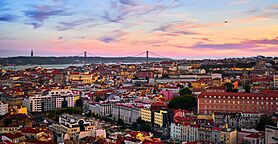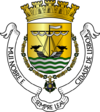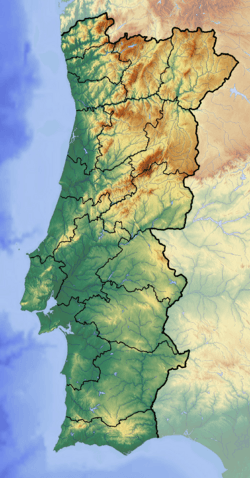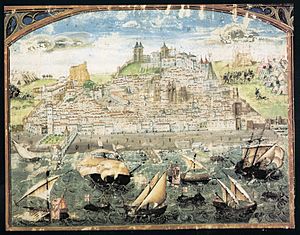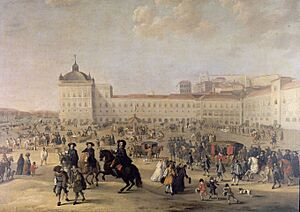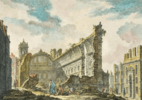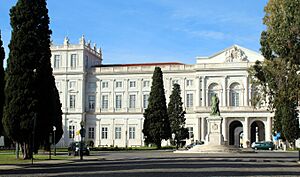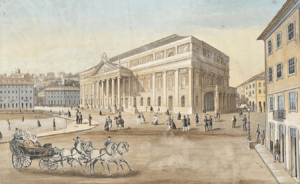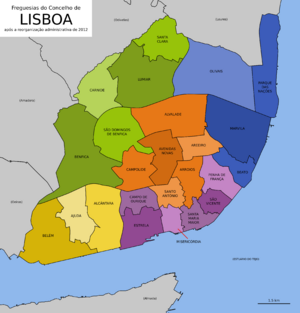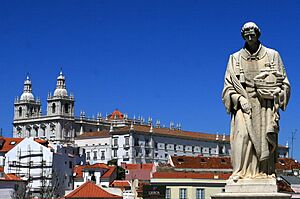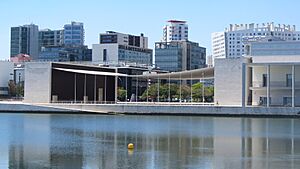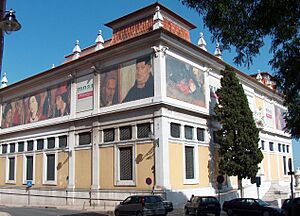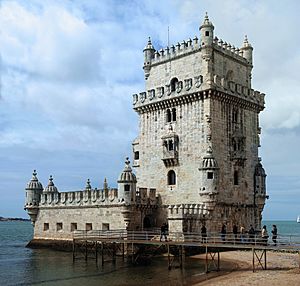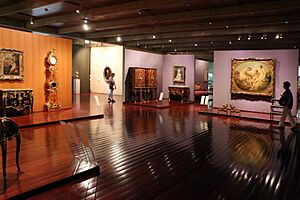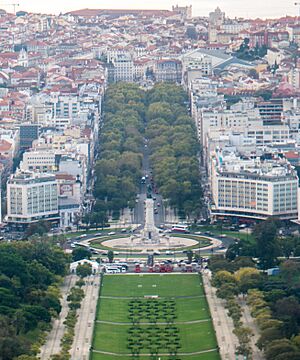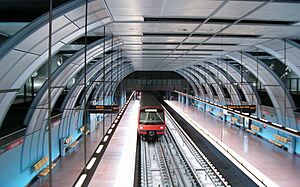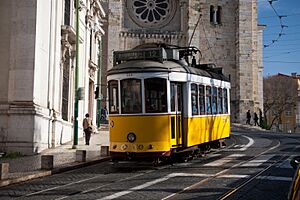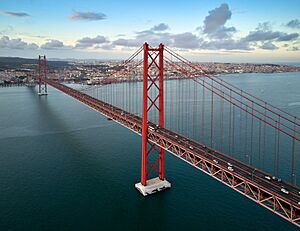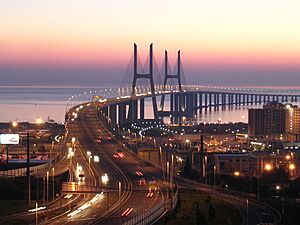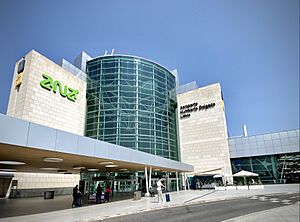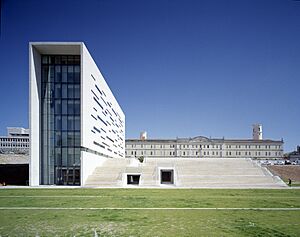Lisbon facts for kids
Quick facts for kids
Lisbon
Lisboa
|
|||||
|---|---|---|---|---|---|
|
Skyline of Lisbon with the 25 de Abril Bridge and Christ the King in the background
Belém Tower
Rua Augusta Arch
Monument of the Discoveries
Jerónimos Monastery
Lisbon Cathedral
Vasco da Gama Tower (left) in the Parque das Nações with Vasco da Gama Bridge (background)
|
|||||
|
|||||
| Motto(s):
Mui Nobre e Sempre Leal
"Very Noble and Always Loyal" |
|||||
| Country | |||||
| Metro | Lisbon metropolitan area | ||||
| District | Lisbon | ||||
| Historic province | Estremadura | ||||
| Settlement | c. 1200 BCE | ||||
| Roman Olissipo | c. 138 BCE | ||||
| Moorish rule | 711 CE | ||||
| Siege of Lisbon | 1147 CE | ||||
| Capital city | 1256 CE | ||||
| Civil parishes | (see text) | ||||
| Government | |||||
| • Type | Local administrative unit | ||||
| • Body | Concelho/Câmara Municipal | ||||
| Area | |||||
| • Capital city | 100.05 km2 (38.63 sq mi) | ||||
| • Metro | 3,015.24 km2 (1,164.19 sq mi) | ||||
| Elevation | 2 m (7 ft) | ||||
| Population | |||||
| • Capital city | 567,131 | ||||
| • Density | 5,445.7/km2 (14,104/sq mi) | ||||
| • Metro | 2,961,177 | ||||
| Demonym(s) | Lisboan Lisboeta Olissiponense Alfacinha (colloquial) |
||||
| Time zone | UTC (WET) | ||||
| • Summer (DST) | UTC+1 (WEST) | ||||
| Postal zone |
1000-000 to 1999-XXX Lisboa
|
||||
| Area code(s) | (+351) 21 XXX XXXX | ||||
| Patron saint | Vincent of Saragossa and Anthony of Lisbon | ||||
| Municipal address | Praça do Município, 1 1149-014 Lisboa |
||||
| Municipal holidays | 13 June (St. Anthony's Day) | ||||
Lisbon (pronounced LIZ-bən) is the capital and largest city of Portugal. In 2023, about 567,131 people lived within its city limits. If you include the wider metropolitan area, the population is around 2.96 million. Lisbon is the westernmost capital city in mainland Europe. It is located on the northern shore of the Tagus River in the western part of the Iberian Peninsula.
Lisbon is one of the oldest cities in the world. It is the second-oldest European capital city, after Athens. The city was first settled by ancient tribes and later developed by the Phoenicians. The Romans also made it an important city. After the Roman Empire fell, different Germanic tribes ruled it. In the 8th century, the Moors took control. In 1147, Afonso Henriques conquered the city back for Christians. In 1255, Lisbon became the capital of Portugal, taking over from Coimbra. Since then, it has been the main center for politics, economy, and culture in the country.
As Portugal's political heart, Lisbon is home to the government, the National Assembly, and the Supreme Court. The President also lives here. Many countries have their ambassadors in Lisbon, making it a key place for international talks. The Lisbon metropolitan area is the third largest in the Iberian Peninsula, after Madrid and Barcelona. About 27.83% of Portugal's population lives here.
Lisbon is known as an important global city. It is a major center for finance, trade, fashion, media, entertainment, arts, education, and tourism. It is one of only two Portuguese cities recognized as a global city (the other being Porto). Lisbon is a big economic hub in Europe, with a growing financial industry. The Lisbon region has a higher GDP per capita than any other part of Portugal. Many international companies have their main offices in the Lisbon area.
Contents
- Understanding Lisbon's Name
- Lisbon's Long History
- Lisbon's Geography
- Where is Lisbon?
- Lisbon's Climate
- Lisbon's Neighborhoods and Parishes
- Alcântara: From Farms to Nightlife
- Alfama: Lisbon's Oldest Quarter
- Mouraria: The Moorish Quarter
- Bairro Alto: Lisbon's Lively Nightlife
- Baixa: The Rebuilt City Center
- Beato: A Modern Cultural Hub
- Belém: Explorers and Monuments
- Chiado: Shopping and Culture
- Estrela: Grand Buildings and Parks
- Parque das Nações: Lisbon's Modern Side
- Lisbon's Culture and Attractions
- Lisbon's Population
- Lisbon's Economy
- Getting Around Lisbon
- Education in Lisbon
- Sports in Lisbon
- Lisbon's International Connections
- Images for kids
- See also
Understanding Lisbon's Name
The name Lisbon might come from ancient Celtic words like Olisippo or Lissoppo. Other old groups like the Phoenicians, Greeks, and Romans changed the name to fit their languages. Some old writers even linked Lisbon's name to the mythical hero Ulysses.
Another idea is that the name comes from a Phoenician term, Alis-Ubbo, meaning "safe harbor." Even though old digs show Phoenicians were here around 1200 BC, this idea about the name isn't found in ancient writings.
Today, people often shorten Lisbon's name to "LX" or "Lx." This comes from an old spelling of the city's name, Lixbõa. Even though that old spelling isn't used anymore, the short form is still very popular.
Lisbon's Long History
Early Beginnings of Lisbon
During the Stone Age, tribes lived in the Lisbon area. They built large stone monuments like dolmens and menhirs, which you can still see today. Later, around 1000 BC, the Celts arrived and mixed with these local people.
Even though the oldest forts on Castle Hill are from the 2nd century BC, recent digs show people lived there much earlier, from the 8th to 6th centuries BC. These early settlers traded with the Phoenicians. This is why Phoenician pottery has been found. Archeologists found proof of Phoenicians in this area as far back as 1200 BC. They set up a trading post on the southern side of Castle Hill. The Tagus River estuary offered a safe harbor for their ships. This settlement was important for trading metals, salt, and fish with tribes further inland.
A popular old story says that the city was named after the mythical hero Ulysses. He supposedly founded the city when he sailed to the edge of the known world.
Lisbon in Roman Times
After defeating Hannibal in 202 BC, the Romans wanted to take over the Iberian Peninsula. The city, then called Olissipo, helped the Romans fight against local tribes. Because of this, it became a Roman town called Municipium Cives Romanorum Felicitas Julia. Its citizens gained Roman rights and didn't have to pay taxes.
Local tribes often raided the area, so the Romans built a wall around the city. During the time of Emperor Augustus, the Romans built many important structures. These included a large theater, baths, temples to their gods, and a big public square (forum). Many of these old ruins were found in the 1700s.
The city grew rich as trade became safer. It was known for its garum (a special fish sauce), wine, salt, and horses. Roman culture spread throughout the area. The city was connected by roads to other big Roman cities. Lisbon became an important center for spreading Christianity. Its first known Bishop was Potamius around 356 AD.
Lisbon in the Middle Ages
After the Roman Empire fell, different groups like the Sarmatians, Alans, and Vandals took over Lisbon. Then, the Suebi, a Germanic group, ruled until 585 AD. After that, the Visigoths, another Germanic group, took control of the whole Iberian Peninsula. Lisbon was then called Ulishbona.
On August 6, 711, Muslim forces from the Umayyad Caliphate captured Lisbon. They built many mosques and houses. They also rebuilt the city wall, known as the Cerca Moura. They allowed different groups of people, like Arabs, Berbers, and Jews, to keep their ways of life. Most Christians spoke Mozarabic, but Arabic was also widely used. Islam was the main religion.
You can still see Muslim influence in the Alfama district today. This old part of Lisbon survived the 1755 Lisbon earthquake. Many street names come from Arabic, and Alfama itself comes from the Arabic word "al-hamma" (meaning fountains or baths).
For a short time, Lisbon was an independent Muslim kingdom (1022–1094). In 1108, Norwegian crusaders led by Sigurd I raided and held Lisbon for three years. The Moorish Almoravids then took it in 1111.

In 1147, Afonso I of Portugal besieged and recaptured Lisbon with the help of crusader knights. The city, with about 154,000 people, returned to Christian rule. This event was very important for Lisbon's history. Some Muslim residents became Catholic, but most who didn't convert left for other Muslim lands. All mosques were either destroyed or turned into churches. Arabic quickly disappeared from daily life.
Because of its central location, Lisbon became the capital of Portugal in 1255. The first Portuguese university was started in Lisbon in 1290 by King Denis I.
In 1384, King Juan I of Castille tried to take the city, but the Portuguese, led by Nuno Álvares Pereira, won. During the later Middle Ages, Lisbon grew a lot and became an important trading center.
Lisbon in Early Modern Times
When Spain forced Jews out of their country, many came to Lisbon. King Manuel I knew Jews were important for the city's success. But in 1497, he ordered all Jews to become Christian. Those who refused had to leave and lost their property. In 1506, a terrible event happened: a massacre of thousands of new Christians, who were Jewish descendants. The king was very angry and punished those who started it.
Most of Portugal's famous voyages of discovery, like Vasco da Gama's trip to India in 1498, started from Lisbon. The 1500s were Lisbon's golden age. The city became a main trading hub between Africa, India, the Far East, and later, Brazil. It became very rich from trading spices, slaves, sugar, and other goods. This time also saw the rise of the beautiful Manueline style in architecture. You can see it in monuments like Belém Tower and Jerónimos Monastery, which are now UNESCO World Heritage Sites.

From 1580 to 1640, Portugal was ruled by the Spanish kings. In 1589, the English, led by Francis Drake, tried to attack Lisbon but failed. The Portuguese Restoration War started in 1640. This war, led by nobles and merchants in Lisbon, brought back Portugal's independence.
In the early 1700s, gold from Brazil helped King John V build many grand churches and theaters in the city. Before the 1700s, Lisbon had many earthquakes. For example, in 1531, an earthquake destroyed 1,500 houses.
On November 1, 1755, a huge earthquake destroyed Lisbon. It killed an estimated 30,000 to 40,000 people and ruined 85 percent of the city's buildings. Important places like the Ribeira Palace were lost. A tsunami followed, killing many people in coastal areas.
Lisbon was one of Europe's largest cities in 1755. The earthquake shocked all of Europe. After the earthquake, the city was rebuilt by Prime Minister Sebastião José de Carvalho e Melo, also known as the Marquis of Pombal. He decided to tear down what was left and rebuild the city center with a modern plan. This new area is called the Baixa Pombalina. It was built with straight streets and two large squares: the Praça do Rossio and the Praça do Comércio. The Praça do Comércio became the city's main entrance from the Tagus River. This rebuilding was one of the first examples of earthquake-resistant building.
Lisbon in Modern Times
In the early 1800s, Napoléon Bonaparte's troops invaded Portugal. The royal family had to flee to Brazil for a while. When the king returned, many buildings in Lisbon were damaged.
During the 1800s, new changes came to the city. The Baixa and Chiado areas grew with many shops, cafes, and theaters. As industry and trade grew, the city expanded. A park called the Passeio Público was turned into the Avenida da Liberdade, a wide avenue.
Lisbon was where King Carlos I of Portugal was killed in 1908. This event led to the creation of the First Republic two years later.
The city reopened its university in 1911. Today, Lisbon has two public universities (University of Lisbon and New University of Lisbon) and other higher education schools.
During World War II, Lisbon was one of the few neutral ports in Europe. It became a major escape route for refugees fleeing Nazi Germany. More than 100,000 refugees found safety here.
Under the Estado Novo government (1926–1974), Lisbon grew a lot. New homes and public buildings were constructed. The Belém area was changed for the 1940 Portuguese Exhibition. The bridge over the Tagus River was opened, connecting both sides of the river quickly.
Lisbon saw three revolutions in the 20th century. The first, in 1910, ended the monarchy and started the First Republic. The second, in 1926, ended the First Republic and began the Estado Novo regime.
Lisbon Today
The Carnation Revolution on April 25, 1974, ended the Estado Novo government. This led to the country becoming the Portuguese Third Republic we know today.
In the 1990s, many parts of Lisbon were updated. Old buildings were fixed, and new projects started in historic areas. The northern bank of the Tagus River was changed for fun activities and homes. The Vasco da Gama Bridge was built. The eastern part of the city was used for Expo '98. This event celebrated 500 years since Vasco da Gama's sea trip to India.
In 1988, a fire in the historic Chiado district destroyed many old buildings. After more than 10 years of rebuilding, the area looks like it used to. It is now a popular shopping area.

The Lisbon Agenda was an agreement by the European Union in 2000 to improve Europe's economy. In 2007, Lisbon hosted a meeting where a new EU plan was agreed upon. This led to the Treaty of Lisbon, signed in 2007.
Lisbon has hosted many big international events. In 1994, it was the European Capital of Culture. In 2005, it hosted the MTV European Music Awards. In 2007, the "New 7 Wonders Of The World" ceremony was held in Lisbon. Every two years, Lisbon hosts the Rock in Rio Lisboa Music Festival. In 2018, it hosted the Eurovision Song Contest for the first time. In August 2023, Lisbon hosted World Youth Day 2023, bringing many young Catholics from around the world. Pope Francis led events, with 1.5 million people at the final mass.
Lisbon's Geography
Where is Lisbon?
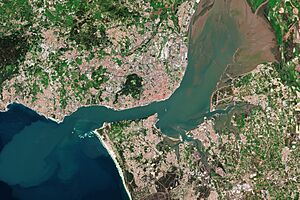
Lisbon is located at the mouth of the Tagus River. It is the westernmost capital city on mainland Europe. The western part of Lisbon has the Monsanto Forest Park. This is a large urban park, about 10 square kilometers, covering 10% of the city.
The city itself covers an area of 100.05 square kilometers. Its city limits are the same as its municipality limits. The wider urban area, called Greater Lisbon, includes other cities and towns. The even larger Lisbon metropolitan area includes the Setúbal Peninsula to the south of the Tagus River.
Lisbon's Climate
Lisbon has a Mediterranean climate. This means it has mild, rainy winters and warm to hot, dry summers. The average yearly temperature is about 17.4°C (63.3°F).
In January, the coldest month, daytime temperatures are usually between 11°C and 19°C (52-66°F). Nighttime temperatures are between 3°C and 13°C (37-55°F). The average sea temperature is 16°C (61°F). In August, the warmest month, daytime temperatures are usually between 25°C and 32°C (77-90°F). Nighttime temperatures are between 14°C and 20°C (57-68°F). The average sea temperature is around 20°C (68°F).
Lisbon has mild winters compared to other European capitals. The coldest temperature ever recorded in Lisbon was -1.2°C (29.8°F) in February 1956. The hottest temperature ever was 44.0°C (111.2°F) on August 4, 2018.
The city gets about 2,806 hours of sunshine each year. It rains about 750 mm (29.5 inches) per year. November and December are the wettest months, while July and August are the driest.
| Climate data for Lisbon (altitude: 77 m.a.s.l., ~1km from sea, location on map) | |||||||||||||
|---|---|---|---|---|---|---|---|---|---|---|---|---|---|
| Month | Jan | Feb | Mar | Apr | May | Jun | Jul | Aug | Sep | Oct | Nov | Dec | Year |
| Record high °C (°F) | 22.6 (72.7) |
24.8 (76.6) |
29.4 (84.9) |
32.4 (90.3) |
34.8 (94.6) |
41.5 (106.7) |
40.6 (105.1) |
44.0 (111.2) |
41.4 (106.5) |
32.6 (90.7) |
25.3 (77.5) |
23.2 (73.8) |
44.0 (111.2) |
| Mean daily maximum °C (°F) | 14.8 (58.6) |
16.2 (61.2) |
18.8 (65.8) |
19.8 (67.6) |
22.1 (71.8) |
25.7 (78.3) |
27.9 (82.2) |
28.3 (82.9) |
26.5 (79.7) |
22.5 (72.5) |
18.2 (64.8) |
15.3 (59.5) |
21.3 (70.4) |
| Daily mean °C (°F) | 11.6 (52.9) |
12.7 (54.9) |
14.9 (58.8) |
15.9 (60.6) |
18.0 (64.4) |
21.2 (70.2) |
23.1 (73.6) |
23.5 (74.3) |
22.1 (71.8) |
18.8 (65.8) |
15.0 (59.0) |
12.4 (54.3) |
17.4 (63.4) |
| Mean daily minimum °C (°F) | 8.3 (46.9) |
9.1 (48.4) |
11.0 (51.8) |
11.9 (53.4) |
13.9 (57.0) |
16.6 (61.9) |
18.2 (64.8) |
18.6 (65.5) |
17.6 (63.7) |
15.1 (59.2) |
11.8 (53.2) |
9.4 (48.9) |
13.5 (56.2) |
| Record low °C (°F) | 1.0 (33.8) |
−1.2 (29.8) |
0.2 (32.4) |
5.5 (41.9) |
6.8 (44.2) |
10.4 (50.7) |
14.1 (57.4) |
14.7 (58.5) |
12.1 (53.8) |
9.2 (48.6) |
4.3 (39.7) |
2.1 (35.8) |
−1.2 (29.8) |
| Average rainfall mm (inches) | 99.9 (3.93) |
84.9 (3.34) |
53.2 (2.09) |
68.1 (2.68) |
53.6 (2.11) |
15.9 (0.63) |
4.2 (0.17) |
6.2 (0.24) |
32.9 (1.30) |
100.8 (3.97) |
127.6 (5.02) |
126.7 (4.99) |
774 (30.47) |
| Average rainy days (≥ 0.1 mm) | 15.0 | 15.0 | 13.0 | 12.0 | 8.0 | 5.0 | 2.0 | 2.0 | 6.0 | 11.0 | 14.0 | 14.0 | 117 |
| Mean monthly sunshine hours | 142.6 | 156.6 | 207.7 | 234.0 | 291.4 | 303.0 | 353.4 | 344.1 | 261.0 | 213.9 | 156.0 | 142.6 | 2,806.3 |
| Source: Instituto Português do Mar e da Atmosfera, Hong Kong Observatory for data of avg. precipitation days & sunshine hours | |||||||||||||
Lisbon's Neighborhoods and Parishes
Lisbon is divided into 24 freguesias, which are like administrative neighborhoods. These were reduced from 53 in 2012.
- Ajuda
- Alcântara
- Alvalade
- Areeiro
- Arroios
- Avenidas Novas
- Beato
- Belém
- Benfica
- Campo de Ourique
- Campolide
- Carnide
- Estrela
- Lumiar
- Marvila
- Misericórdia
- Olivais
- Parque das Nações
- Penha de França
- Santa Clara
- Santa Maria Maior
- Santo António
- São Domingos de Benfica
- São Vicente
Locally, people in Lisbon often talk about the city's historic Bairros (neighborhoods). These areas have their own unique history, culture, and buildings. Some famous ones are Bairro Alto, Alfama, and Chiado.
Alcântara: From Farms to Nightlife
Alcântara used to be a quiet area with farms and noble estates. In the 1500s, nobles would even boat on its brook. By the late 1800s, it became an industrial area with many factories.
In the early 1990s, Alcântara became popular for its pubs and clubs. These were often in old commercial buildings, which helped keep noise away from homes. Now, some areas are being updated with new apartments that have great river views.
The riverfront of Alcântara is famous for its nightlife. Many clubs and bars are in converted dock warehouses, so the area is often called docas (docks).
Alfama: Lisbon's Oldest Quarter
Alfama is Lisbon's oldest district. It stretches from the Castle of São Jorge down to the River Tagus. Its name comes from the Arabic word Al-hamma, meaning fountains or baths. During the Muslim rule, Alfama was the largest part of the city. Over time, it became home to fishermen and poorer residents.
The 1755 Lisbon earthquake caused a lot of damage in Lisbon, but Alfama survived mostly intact. This was thanks to its tight maze of narrow streets and small squares.
Today, Alfama is a historic area with a mix of buildings. You'll find Fado bars, restaurants, and homes with small shops. Fado, Portugal's sad and soulful music, is often played in the district's restaurants.
Mouraria: The Moorish Quarter
The Mouraria, or Moorish quarter, is one of Lisbon's oldest neighborhoods. Its name comes from the fact that after Lisbon was recaptured by Christians, Muslims who stayed were limited to this part of the city.
Bairro Alto: Lisbon's Lively Nightlife
Bairro Alto means "the upper quarter" in Portuguese. It's a central area in Lisbon with homes, shops, and lots of entertainment. It's known as the heart of Lisbon's nightlife. Many different music styles and subcultures can be found here.
The crowds in Bairro Alto are a mix of people from all walks of life. While new music scenes thrive, Fado, Portugal's national music, is still heard in some places.
Baixa: The Rebuilt City Center
The heart of Lisbon is the Baixa or city center. This elegant area was mostly built after the 1755 Lisbon earthquake. It's named after the Marquis of Pombal, who was a key figure in rebuilding Lisbon.
After the disaster, Pombal decided to clear the ruins and rebuild the city center with a modern plan. He made strict rules for building. The result is a grid pattern of streets, making it one of the first examples of earthquake-resistant building. Buildings here have special wooden frames to help them stand strong during earthquakes.
Beato: A Modern Cultural Hub
The Beato area is becoming known for its new cultural scene. Old factory buildings and industrial areas by the river are now home to art galleries, cool bars, and great restaurants. This has brought a lot of attention to the area.
Beato also has treasures like the National Museum of the Azulejo (tile museum) and the Palacio do Grilo.
Belém: Explorers and Monuments
Belém is famous as the starting point for many great Portuguese explorers. Vasco da Gama left from here for India in 1497, and Pedro Álvares Cabral left for Brazil in 1499. It was also a royal residence. You can see the 17th-18th century Belém Palace, now home to the President of Portugal, and the Ajuda Palace.
Belém's most famous landmark is the Torre de Belém. This tower was built around 1515-1520 as a fortified lighthouse to guard the port entrance. It used to be on a small island. Belém's other major historic building is the Mosteiro dos Jerónimos (Jerónimos Monastery). The tower was partly built to protect this monastery.
A notable modern landmark is the Padrão dos Descobrimentos (Monument to the Discoveries). It was built for the 1940 Portuguese World Fair. In the center of Belém is the Praça do Império, a garden with a large fountain. Belém is one of Lisbon's most visited districts.
Chiado: Shopping and Culture

The Chiado is a traditional shopping area. It has both old and new stores, especially on Rua do Carmo and Rua Garrett. Locals and tourists come here to buy books, clothes, and pottery, or to enjoy a coffee. The most famous cafe is A Brasileira, known for being a favorite spot of poet Fernando Pessoa.
Chiado is also an important cultural area with museums and theaters, including the opera house. In 1988, a fire destroyed many 18th-century buildings here. But thanks to a long restoration project, the area has almost fully recovered.
Estrela: Grand Buildings and Parks
The beautiful Estrela Basilica from the late 1700s is the main attraction in this district. This church, with its large dome, can be seen from far away. Its style is similar to the Mafra National Palace, mixing late baroque and neoclassical designs.
The São Bento Palace, where the Portuguese parliament meets, is also in this district. The official homes of the Prime Minister of Portugal and the President of the Assembly of the Republic of Portugal are here too. Estrela Park is a popular spot for families. It has exotic plants, a duck pond, sculptures, and a playground. Many cultural events like outdoor movies and music festivals happen here all year.
Parque das Nações: Lisbon's Modern Side
Parque das Nações (Park of Nations) is Lisbon's newest district. It was built for the 1998 World Exhibition, also called Expo'98. The area changed a lot and now has a modern, futuristic look. It has become a popular area for businesses and upscale homes.
At the center of this area is the Gare do Oriente (Orient railway station). This is a major transport hub for trains, buses, taxis, and the metro. Its glass and steel design is inspired by Gothic architecture.
The Parque das Nações is easy to walk around. It has new buildings, restaurants, gardens, the Casino Lisbon, and the Oceanário de Lisboa (Lisbon Oceanarium), which is the second-largest in the world. The district's Altice Arena is a big venue for concerts and sports events.
Lisbon's Culture and Attractions
Lisbon is rich in different styles of buildings. You can find Romanesque, Gothic, Manueline, Baroque, and modern buildings all over the city. There are also historic avenues and monuments, especially in the upper parts of the city. The Avenida da Liberdade (Avenue of Liberty) is a famous example.
Lisbon has many important museums and art collections. The National Museum of Ancient Art has one of the largest art collections in the world. The National Coach Museum has the world's biggest collection of royal coaches. These are the two most visited museums in the city. Other national museums include the National Museum of Archaeology and the National Azulejo Museum (tile museum).
Important private museums include the Gulbenkian Museum. It has one of the largest private collections of old art in the world. The Berardo Collection Museum also has a large private art collection.
Lisbon's Opera House, the Teatro Nacional de São Carlos, has many cultural events, especially in autumn and winter. Other important theaters are the Centro Cultural de Belém and the Teatro Nacional D. Maria II.
The Christ the King monument (Cristo-Rei) stands on the south bank of the Tagus River. It looks like the famous statue in Rio de Janeiro. It was built after World War II to thank Portugal for being spared from the war's destruction.
June 13 is Lisbon's holiday, honoring Anthony of Lisbon (Santo António). Saint Anthony was a wealthy Portuguese man who became a saint after preaching to the poor.
Eduardo VII Park is the second-largest park in the city. It has many flowering plants and green spaces. It was renamed after Edward VII of England visited Lisbon in 1903.
Lisbon hosts many festivals and events each year. These include the Lisbon Gay & Lesbian Film Festival, the DocLisboa – Lisbon International Documentary Film Festival, and the Lisbon Book Fair.
Lisbon has two sites listed by UNESCO as World Heritage Sites: Belém Tower and Jerónimos Monastery. In 1994, Lisbon was the European Capital of Culture. In 1998, it hosted the Expo '98 (1998 Lisbon World Exposition).
Lisbon is also known for its beautiful azulejo tile art. These ceramic tiles are used to decorate buildings, both inside and out, since the 15th century. You can see this art at the National Museum of the Azulejo. Also, the mosaic Portuguese pavement (Calçada Portuguesa) started in Lisbon in the mid-1800s. Many walkways and streets in the city are still made in this style.
In May 2018, Lisbon hosted the 63rd edition of the Eurovision Song Contest. In August 2023, it hosted World Youth Day 2023.
Lisbon's Population
| Historical population | |||||||||||||||||||||||||||||||||||||||||||||||||||||||||||||||||||||||||||||||||||||
|---|---|---|---|---|---|---|---|---|---|---|---|---|---|---|---|---|---|---|---|---|---|---|---|---|---|---|---|---|---|---|---|---|---|---|---|---|---|---|---|---|---|---|---|---|---|---|---|---|---|---|---|---|---|---|---|---|---|---|---|---|---|---|---|---|---|---|---|---|---|---|---|---|---|---|---|---|---|---|---|---|---|---|---|---|---|
|
|
||||||||||||||||||||||||||||||||||||||||||||||||||||||||||||||||||||||||||||||||||||
| Source: INE | |||||||||||||||||||||||||||||||||||||||||||||||||||||||||||||||||||||||||||||||||||||
Lisbon's population was about 35,000 in 1300. It grew to 200,000 by 1552. In 2023, Lisbon had 567,131 people living in its main administrative area. The city's population density is about 5,668.5 people per square kilometer.
The larger Lisbon metropolitan area includes about 2.96 million people. This makes it the eleventh largest urban area in the European Union.
Religion in Lisbon
Religion in the municipality of Lisbon (Census 2021) Catholicism (65.59%) Orthodoxy (0.68%) Protestantism (2.44%) Jehovah's Witnesses (0.61%) Other Christian (1.27%) Buddhism (0.54%) Hinduism (1.07%) Judaism (0.12%) Islam (1.63%) Other Religion (0.50%) No Religion (25.55%)
According to the 2021 Portuguese Census, the largest religion in Lisbon is Roman Catholicism. About 66% of people in Lisbon city are Catholic. This number is higher than in the wider metropolitan area.
Immigration in Lisbon
Lisbon's population has been decreasing as people move to other parts of Greater Lisbon for more affordable housing. Also, many homes in the city center have become tourist rentals, which makes it harder to find places to live.
| Largest groups of foreign residents in 2022 | |
| Nationality | Population |
|---|---|
| 22,080 | |
| 9,391 | |
| 9,033 | |
| 8,875 | |
| 8,486 | |
Lisbon's Economy
The Lisbon region is the wealthiest part of Portugal. It produces 45% of the country's total economic output (GDP).
Lisbon's economy mainly relies on the tertiary sector, which means services. Most international companies operating in Portugal have their main offices in the Greater Lisbon area. The Lisbon metropolitan area also has a lot of industry, especially south of the Tagus river. Key industries include oil refining, textiles, shipbuilding, and fishing.
Lisbon is Portugal's main seaport. It is also growing as an important financial center and a technology hub. Car manufacturers have factories in the suburbs, like AutoEuropa.
Lisbon has the largest media sector in Portugal. Many leading TV networks, radio stations, and major newspapers are based here. Euronext Lisbon is the local stock exchange, part of the larger Euronext system.
Before Portugal's economic crisis, Lisbon had plans for many big projects. These included a new airport, a new bridge, and expanding the metro system.
In 2021, Lisbon was ranked the 7th most "livable city" in the world by Monocle magazine.
Tourism is also a very important industry. Lisbon is the ninth-most-visited city in Southern Europe. In 2019, it had 3,639,900 tourists. In 2022, there were about 6 tourists for every resident. Around 7.7 million tourists visited the Lisbon region in 2022.
Getting Around Lisbon
Lisbon Metro System
The Lisbon Metro connects the city center with other districts and some suburbs. It's the fastest way to travel around the city. It also connects to other types of transport. Getting from Lisbon Airport to the city center takes about 25 minutes by metro.
In 2019, the Lisbon Metro served about 173 million passengers. As of 2018, it has four lines (blue, yellow, green, and red) and 56 stations. The total length is 44.2 km. There are plans to expand the system, including making the Green Line a circular route.
Lisbon Trams
Trams are a traditional way to get around Lisbon. They started in 1901 and were first imported from the US. People called them americanos (Portuguese for "American").
Except for the modern Line 15, Lisbon's tram system still uses small, old-style vehicles from the early 1900s. These yellow trams are a famous symbol of Lisbon. Their small size is perfect for the city's steep hills and narrow streets.
You can see the oldest trams at the Carris Museum (Lisbon Public Transport Museum). The tram network is 31 kilometers long with 6 lines. It used to be much larger. New trams are being added, and the system is planned to expand.
Lisbon Trains

There are four commuter train lines leaving Lisbon. These go to Sintra, Azambuja, Cascais, and Sado. There's also a fifth line to Setúbal that crosses the Tagus river on the 25 de Abril Bridge. The main train stations are Santa Apolónia, Rossio, Gare do Oriente, Entrecampos, and Cais do Sodré.
Lisbon Buses
The local bus service in Lisbon is run by Carris. Carris has 741 buses, and more will be added soon. The bus network is 748 km long and has 99 routes. There have been many improvements in recent years.
Outside Lisbon, two main bus services connect cities to Lisbon. These are Carris Metropolitana and Barraqueiro Transportes.
Lisbon Bridges
Two important bridges connect Lisbon to the other side of the Tagus River:
- The 25 de Abril Bridge opened in 1966. It was once the longest suspension bridge in Europe. It was renamed after the Carnation Revolution.
- The Vasco da Gama Bridge opened in 1998. At 17.2 km (10.7 mi), it is the longest bridge in Europe.
Plans for a third bridge across the Tagus have been put on hold due to economic reasons. However, in 2024, the government announced that a new international airport would be built in Alcochete, across the Tagus, which might affect future bridge plans.
Lisbon Ferries
You can also cross the river by ferry. The company Transtejo & Soflusa runs ferries from Lisbon to different places like Cacilhas, Seixal, and Montijo. Ferry stations in Lisbon include Belém River Station and Terreiro do Paço River Station.
Air Travel in Lisbon
Humberto Delgado Airport is located within the city limits. It is the main base for TAP Portugal and a hub for other airlines. In 2023, it served over 33.65 million passengers, making it Portugal's busiest airport. It is also one of the busiest in Europe.
A second airport has been planned for a long time. In 2024, the new government announced that the new international airport will be built in Alcochete, across the Tagus from Lisbon.
Cascais Municipal Aerodrome, about 20 km west of Lisbon, offers domestic flights. Many aviation schools are also located here.
Cycling in Lisbon
Since the Covid-19 pandemic, cycling has become much more popular in Lisbon. The city plans to expand its Gira bike hire system to 2,600 bikes by the end of 2023. Many of these are electric bikes to help with Lisbon's hills. The city also plans to add more bike recharging stations. The Gira service is part of the public transport system, and young people and seniors can use it for free.
In 2023, Lisbon had over 200 kilometers of bike lanes. The city plans to expand this network even more.
Public Transport Statistics
On average, people in Lisbon spend 59 minutes commuting with public transport on a weekday. About 11.5% of riders travel for more than 2 hours daily. The average wait time at a stop is 14 minutes. The average distance traveled in one trip is 6 km.
Driving in Lisbon
Lisbon is connected to its suburbs and the rest of Portugal by a large network of motorways. There are three circular motorways around the city.
Education in Lisbon
International Schools in Lisbon
In the wider Lisbon area, especially in the Portuguese Riviera, there are many international schools. These are popular with expats and foreign families. Examples include the Carlucci American International School of Lisbon, Saint Julian's School (British), and Deutsche Schule Lissabon (German).
Higher Education in Lisbon
Lisbon has three public universities and one university institute. The University of Lisbon is the largest university in Portugal. It was formed in 2013 by combining two older universities. The New University of Lisbon, founded in 1973, is another public university. It is known for its business and economics school. The third public university is Universidade Aberta. There is also ISCTE - Lisbon University Institute, which offers degrees in many subjects.
Major private universities include the Portuguese Catholic University.
In the 2007–2008 school year, over 125,000 students were enrolled in higher education in Lisbon.
Libraries and Archives in Lisbon
Lisbon is home to the Biblioteca Nacional de Portugal, which is Portugal's national library. It has over 3 million books and old writings. It holds rare items like an original Gutenberg Bible. The Torre do Tombo National Archive is one of the most important archives in the world. It is over 600 years old and holds many historical documents.
Sports in Lisbon
Lisbon has a strong history in sports. It hosted several matches, including the final, of the UEFA Euro 2004 football championship. The city also hosted the final of the 2001 IAAF World Indoor Championships in athletics. From 2006 to 2008, Lisbon was the starting point for the Dakar Rally. The city hosted the 2014 and 2020 UEFA Champions League finals in football.
Football in Lisbon
Lisbon has three professional football clubs in Portugal's top league, the Primeira Liga. Sport Lisboa e Benfica, or Benfica, has won 38 league titles and two European Cups. Lisbon's second most successful club is Sporting Clube de Portugal, or Sporting. They have won 20 league titles and the UEFA Cup Winners' Cup. A third club, C.F. Os Belenenses, has won one league title.
Lisbon has two top-rated football stadiums. Benfica's Estádio da Luz (Stadium of Light) can hold over 65,000 people. Sporting's Estádio José Alvalade can hold over 50,000. The Estádio da Luz hosted both the 2014 and 2020 UEFA Champions League finals.
Other Sports in Lisbon
Other sports like basketball, futsal, handball, roller hockey, rugby, and volleyball are also popular. Lisbon has many sports facilities for athletics, sailing, golf, and mountain biking. The city hosts the Lisbon Half Marathon every March and the Portugal Half Marathon in September.
Lisbon's International Connections
Twin Towns and Sister Cities
Lisbon is twinned with many cities around the world:
 Bissau, Guinea-Bissau (1985)
Bissau, Guinea-Bissau (1985) Budapest, Hungary (1992)
Budapest, Hungary (1992) Cacheu, Guinea-Bissau (1988)
Cacheu, Guinea-Bissau (1988) Fortaleza, Brazil (2016)
Fortaleza, Brazil (2016) Guimarães, Portugal (1993)
Guimarães, Portugal (1993) Luanda, Angola (1988)
Luanda, Angola (1988) Macau, China (1982)
Macau, China (1982) Madrid, Spain (1979)
Madrid, Spain (1979) Malacca City, Malaysia (1984)
Malacca City, Malaysia (1984) Maputo, Mozambique (1982)
Maputo, Mozambique (1982) Praia, Cape Verde (1983)
Praia, Cape Verde (1983) Rabat, Morocco (1988)
Rabat, Morocco (1988) Panaji, India
Panaji, India Rio de Janeiro, Brazil (1980)
Rio de Janeiro, Brazil (1980) Salvador, Brazil (1995)
Salvador, Brazil (1995) São Tomé, São Tomé and Príncipe (1985)
São Tomé, São Tomé and Príncipe (1985)
Cooperation Agreements
Lisbon also has cooperation agreements with these cities:
 Algiers, Algeria (1988)
Algiers, Algeria (1988) Asunción, Paraguay (2014)
Asunción, Paraguay (2014) Bangkok, Thailand (2016)
Bangkok, Thailand (2016) Beijing, China (2007)
Beijing, China (2007) Bethlehem, Palestine (1995)
Bethlehem, Palestine (1995) Buenos Aires, Argentina (1992)
Buenos Aires, Argentina (1992) Curitiba, Brazil (2005)
Curitiba, Brazil (2005) Haimen, China (2011)
Haimen, China (2011) Kyiv, Ukraine (2000)
Kyiv, Ukraine (2000) Miami, United States (1987)
Miami, United States (1987) Montevideo, Uruguay (1993)
Montevideo, Uruguay (1993) Panaji, India (1989)
Panaji, India (1989) Paris, France (1998)
Paris, France (1998) Qingdao, China (2010)
Qingdao, China (2010) Santa Catarina, Cape Verde (1997)
Santa Catarina, Cape Verde (1997) Sofia, Bulgaria (2001)
Sofia, Bulgaria (2001) Toronto, Canada (1987)
Toronto, Canada (1987) Tunis, Tunisia (1993)
Tunis, Tunisia (1993) Zagreb, Croatia (1977)
Zagreb, Croatia (1977)
Membership in Organizations
Since 1982, Lisbon has been part of the Union of Ibero-American Capital Cities. Since 1985, Lisbon has been part of the Union of Capital Cities of Portuguese Language. This group includes 22 other cities from countries where Portuguese is spoken.
Images for kids
-
The 1755 Lisbon earthquake devastated Lisbon.
See also
 In Spanish: Lisboa para niños
In Spanish: Lisboa para niños


